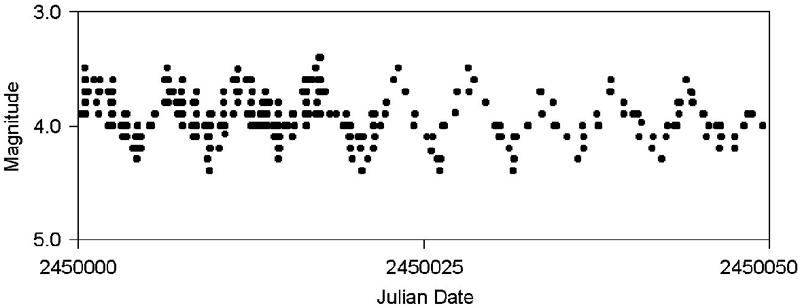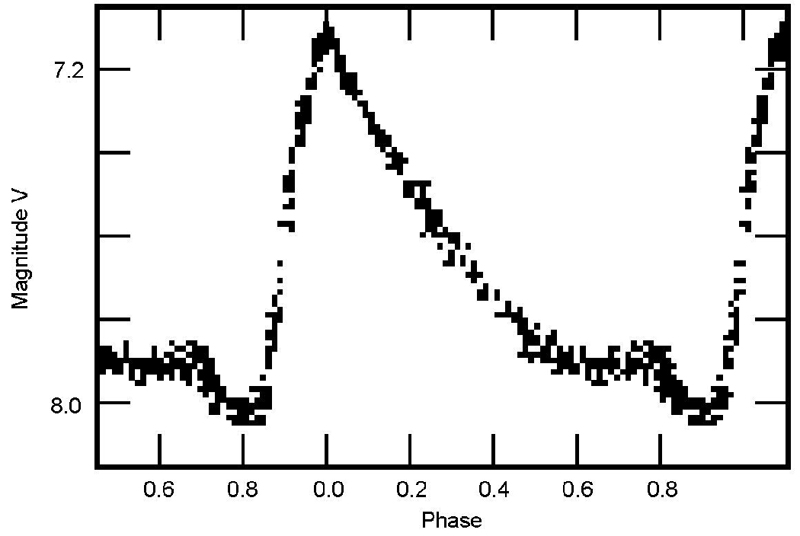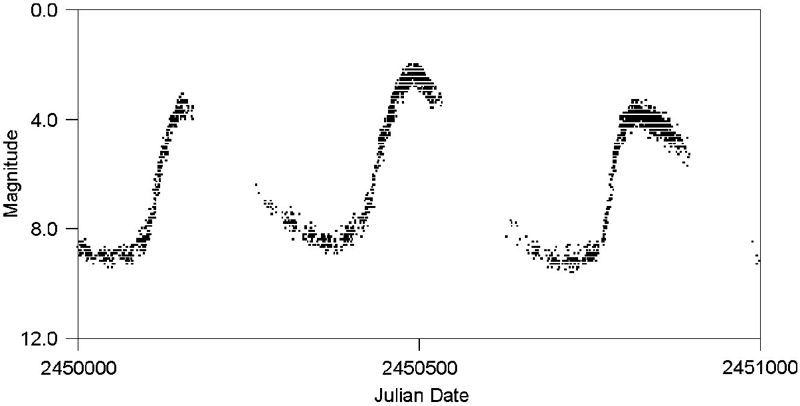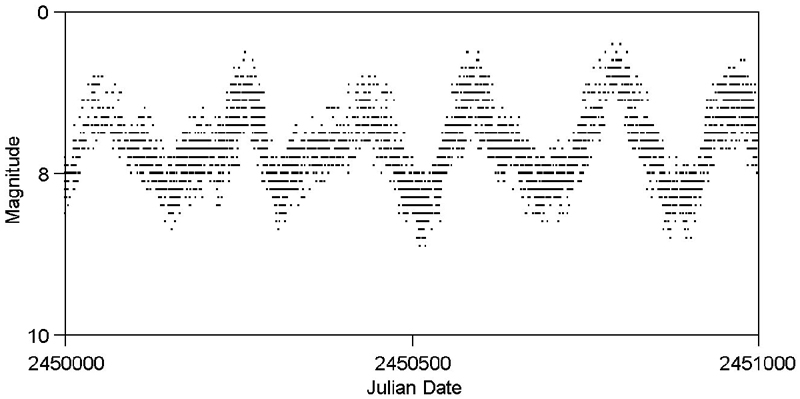The Hertzsprung-Russell (H-R) Diagram:
The H-R diagram is an important astronomical tool for understanding how stars evolve over time. Stellar evolution can not be studied by observing individual stars as most changes occur over millions and billions of years. Astrophysicists observe numerous stars at various stages in their evolutionary history to determine their changing properties and probable evolutionary tracks across the H-R diagram.
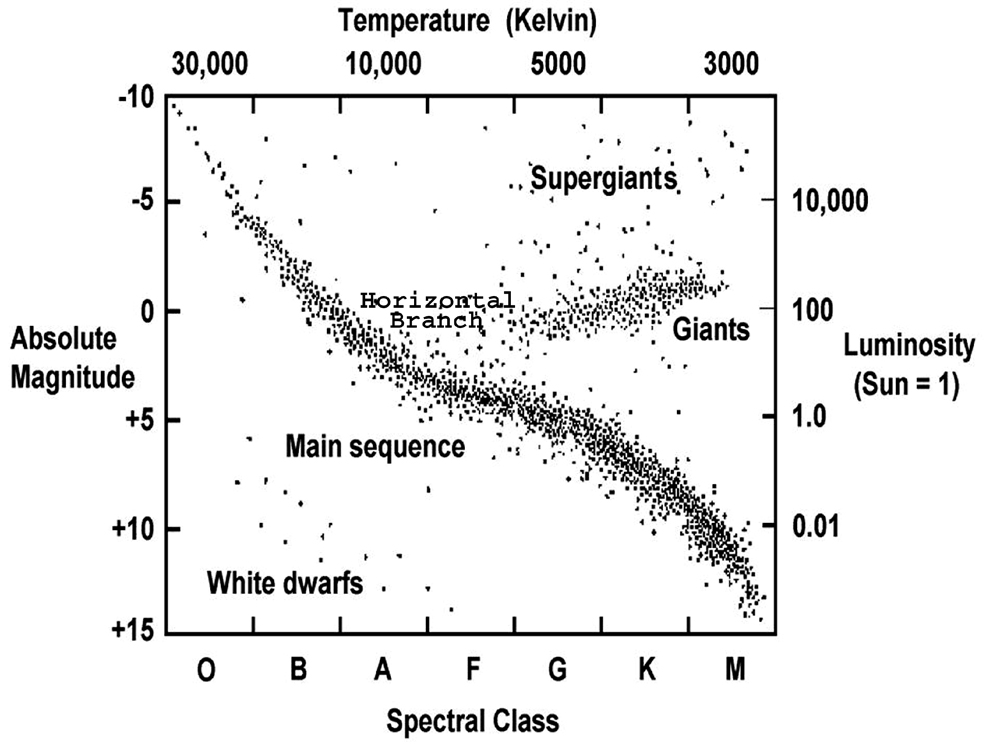
The H-R Diagram
The H-R diagram is a scatter graph of stars. When the absolute magnitude (MV) – intrinsic brightness – of stars is plotted against their surface temperature (stellar classification) the stars are not randomly distributed on the graph but are mostly restricted to a few well-defined regions. The stars within the same regions share a common set of characteristics. As the physical characteristics of a star change over its evolutionary history, its position on the H-R diagram changes also – so the H-R diagram can also be thought of as a graphical plot of stellar evolution. From the location of a star on the diagram, its luminosity, spectral type, color, temperature, mass, age, chemical composition and evolutionary history are known.
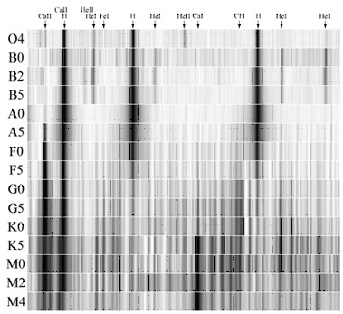
Sample Stellar Spectra
Most stars are classified by surface temperature (spectral type) from hottest to coolest as follows: O B A F G K M. These categories are further subdivided into subclasses from hottest (0) to coolest (9). The hottest B stars are B0 and the coolest are B9, followed by spectral type A0. Each major spectral classification is characterized by its own unique spectra. Though O B A F G K and M are the stellar classifications commonly shown on H-R diagrams, a number of new and extended spectral classes have been designated. These include Wolf-Rayet stars (W), cool dwarfs (L), brown dwarfs (T), carbon stars (C), and stars with zirconium oxide lines that are between M and C stars (S). The carbon stars (C) include stars that were originally classified as R and N stars. Class D (degenerate) is the modern classification for white dwarfs.
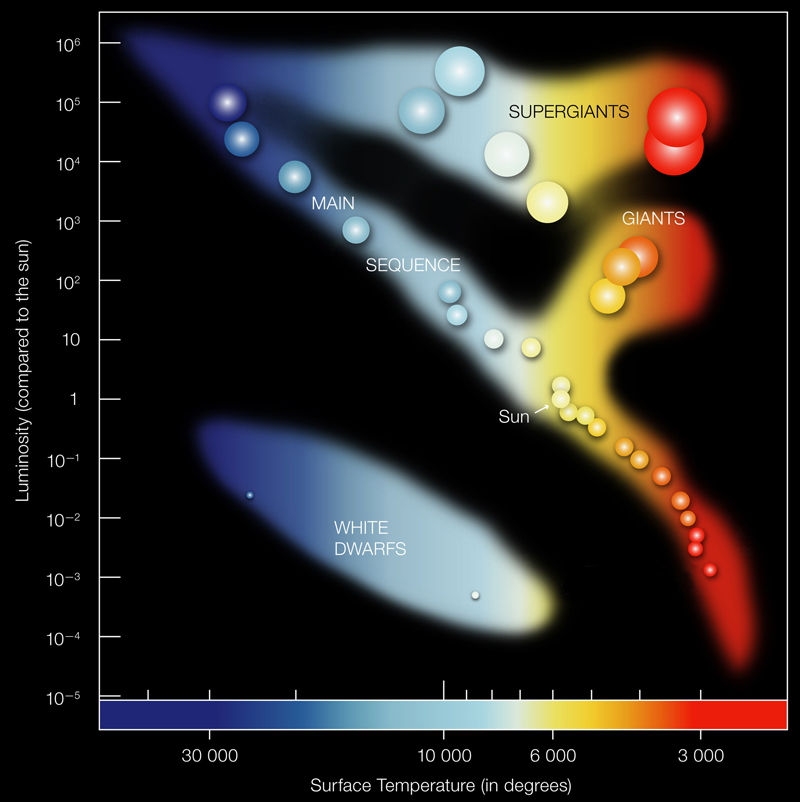
Major Branches on the H-R Diagram
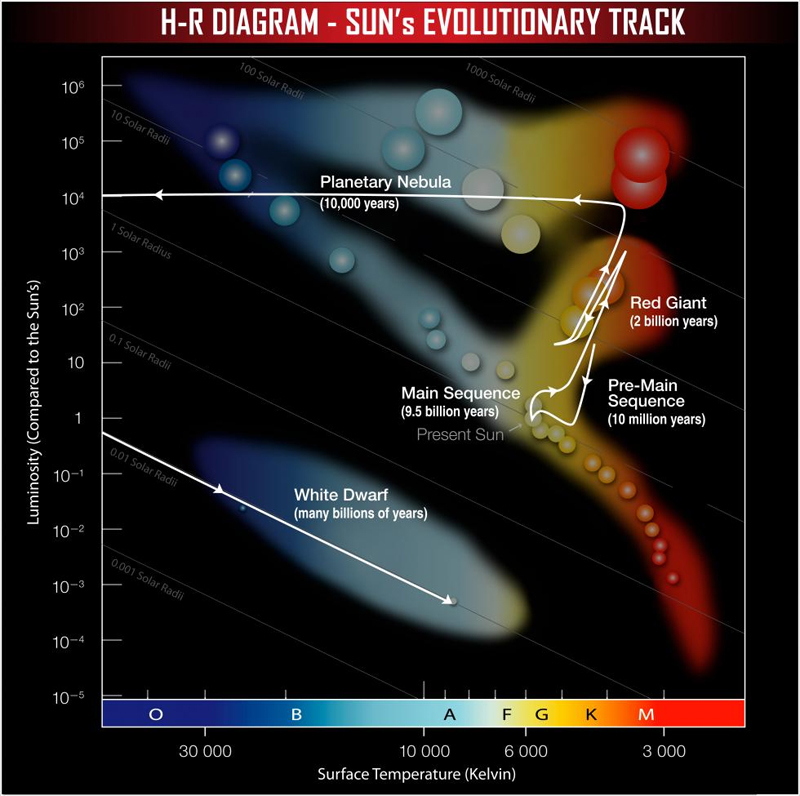
Evolutionary Track of the Sun
Across the H-R Diagram
Starting at the upper left-hand corner and curving down to the lower right-hand corner is a band called the main sequence. ~90% of all stars lie within the main sequence. These stars run from the hot and bright O and B stars at the top left-hand corner to the cool, dim K and M stars at the lower right-hand corner. Main sequence stars have a fairly steady rate of hydrogen fusion ongoing in their cores. In main sequence stars, the radiation pressure pushing outward from the fusion process balanced by the inward pull of gravitational forces maintains a state of dynamic equilibrium. When hydrogen in the core is depleted and radiation pressure decreases, the two forces become unbalanced and the star "moves off the main sequence" and begins a series of evolutionary stages – the final end product(s) depending upon the initial mass of the star. The giant and supergiant branches of the H-R diagram are occupied by stars that have transitioned from the main sequence and are fusing heavier atomic nuclei. As most stars transition from the main sequence to the giant and supergiant branches, they exhibit different types of variability that are also confined to specific regions on the diagram.
Pulsating Variable Stars:As many stars transition from one stage to another on the H-R diagram they vary in brightness. The brightness that a star appears to have (apparent magnitude) from our perspective here on Earth depends upon its distance from Earth and its actual intrinsic brightness, or absolute magnitude (MV). The behavior of stars that vary in magnitude (brightness) can be studied by measuring their changes in brightness over time and plotting the changes on a graph called a light curve. Light curves are usually plots of apparent magnitude over time.
The apparent magnitudes of stars are adjusted to what their values would be without the light extinctions caused by the atmosphere. The Greek astronomer Hipparchus around 129 B.C. designated the brightest stars as first magnitude, and those at the limits of visual observation as sixth magnitude. After centuries of change, the magnitude scale is now established as an open-ended scale with the largest negative numbers the brightest objects and the largest positive numbers the dimmest objects. Vega, the brightest star in the summer sky in the Northern Hemisphere, originally designated as the zero point, has an apparent magnitude of +0.03. Examples of apparent magnitude values are: the Sun as seen from Earth -26.74, the full moon -12.92, Crab supernova (SN 1054) -6.00, Betelgeuse (α Orionis ) -5.6, Venus at brightest -4.89, Sirius (α Canis Majoris) -1.47, M33 (Andromeda Galaxy) +5.72, and Pluto +13.65.
Historically the time scale has been the Julian Day (JD), a counting system starting with January 1, 4713 BC – Julian Day number 1. Currently astronomers are changing to day and/or year as the time scale. Measuring and recording the changes in magnitude and plotting the resulting light curves allow astronomers to determine the period of variation. The period is the amount of time it takes for the star to go through one complete cycle from maximum magnitude through minimum magnitude and back to maximum magnitude.
The different types of pulsating variables are distinguished by their periods of pulsation and the shapes of their light curves. These in turn are a function of their mass and evolutionary stage. Cepheids, RR Lyraes, and Long Period Variables (LPVs) – Miras and Semiregulars – are pulsating variable stars and occupy regions on the H-R diagram called instability strips. The instability occurs as main sequence stars transition to and along the giant and supergiant branches of the H-R diagram.
Cepheid variable stars expand and contract in a repeating cycle of size changes. The change in size can be observed as a change in apparent brightness (apparent magnitude.) Cepheids have a repeating cycle of change that is periodic - as regular as the beating of a heart, with a period of 1 to 70 days with an amplitude variation of 0.1 to 2.0 magnitudes. These massive stars (~8 solar masses) have a high luminosity and are spectral class F at maximum, and G to K at minimum. Cepheids occupy an elongated horizontal instability strip on the H-R diagram as massive stars transition from the main sequence to the giant and supergiant branches. Polaris (α Ursae Minoris) is currently the star nearest to the north celestial pole and referred to as the North Star or Pole Star. Polaris is a multiple star system, consisting of Polaris A, a six solar mass Cepheid variable star, and two main sequence stars Polaris B and Polaris C.
RR Lyrae variables are older pulsating white giants with low metallicity. They are common in globular clusters – dense groups of old stars in the halos of galaxies. Like Cepheids, their pulsations are periodic. RR Lyraes have ~0.5 solar mass and have a short pulsation period of 0.05 to 1.2 days and amplitude variations of 0.3 to 2 magnitudes. RR Lyrae stars are usually spectral class A. RR Lyrae stars occupy a small instability strip near the intersection of the main sequence and the horizontal giant branch (HB). The HB stars have left the red giant branch and are characterized by helium fusion in their cores surrounded by a shell of hydrogen fusion. All of the RR Lyrae stars in a cluster have the same average apparent magnitude. In different clusters, the average apparent magnitude is different. This is because all RR Lyraes have about the same average absolute magnitude of +0.75. Many lower-mass giant stars will go through a RR Lyrae pulsation stage while many higher-mass giant stars will go through a Cepheid stage. Because low-mass stars live longer than high-mass stars, the Cepheid stars as a group are younger than the RR Lyrae stars.
Long Period Variables (LPVs) are pulsating red giants or supergiants with periods ranging from 30-1000 days. They are usually of spectral type M, R, C or N. There are two subclasses; Mira and Semiregular.
Mira variables are periodic pulsating red giants with periods of 80 to 1000 days. It is a stage that most mid-sized main sequence stars transition through as they evolve to the red giant branch. Miras have amplitude variations of more than 2.5 magnitudes. Mira (Omicron Ceti) is the prototype of Mira variable stars. The Sun will eventually transition through a pulsating Mira stage. The Mira instability strip on the H-R diagram is located in a region between mid-sized stars on the main sequence and the giant branch.
Semiregular variables are giants and supergiants showing periodicity accompanied by intervals of semiregular or irregular light variation. Their periods range from 30 to 1000 days, generally with amplitude variations of less than 2.5 magnitudes. Antares (α Scorpius) and Betelgeuse (α Orionis) are two prominent examples of LPV semiregular variable stars. These stars occupy a region of instability on the H-R diagram above the Mira variables and are generally spectral class K, M, C or S.
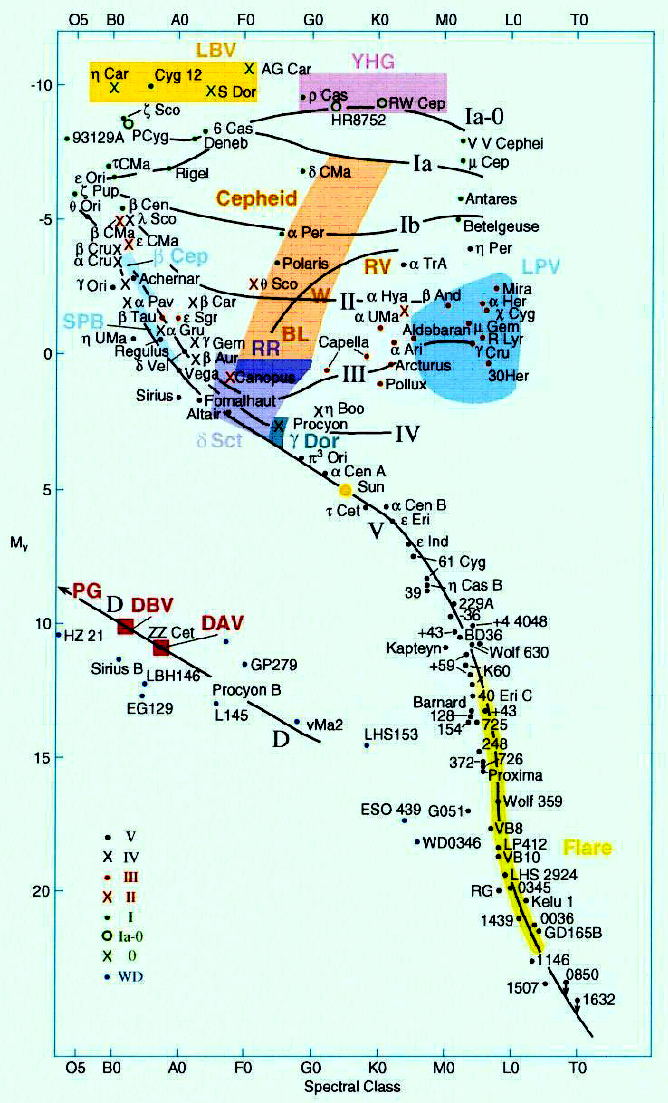
The Cambridge Encyclopedia of
Stars, J B Taylor, © 2006
Since stars are plotted on the H-R diagram by absolute magnitude and/or luminosity and surface temperature (stellar classification), each star is plotted as one data point. Main sequence stars, giants and supergiants, and white dwarfs all occupy specific branches on the diagram. These objects have an absolute magnitude and temperature that does not change except over extremely long time scales as they evolve from one branch or evolutionary stage to another. For simplification, pulsating variables are plotted on H-R diagrams with one data point that represents their average absolute magnitudes and temperatures.
During the transition of Cepheids, RR Lyrae, Mira and Semiregular variable stars through the instability strips they are pulsationally unstable – expanding and brightening, then contracting and become dimmer. The instability strips for Miras and Cepheids are especially elongated because of these expansions and contractions. Some pulsating variable stars change in temperature by two spectral classes during one cycle of change from maximum to minimum. To better understand the degree of variation for individual variable stars, it is necessary to plot them at both extremes of their cycles on the H-R diagram – both at maximum absolute magnitude (MVmax) and minimum absolute magnitude (Mvmin) – along with the corresponding spectral classes.
The H-R diagram on page 7 is a plot of some nearby stars (darker circles) and some bright stars (lighter circles) relative to Earth. The stars define the shape of the main sequence and the regions occupied by giants, supergiants and white dwarfs. Study the H-R diagram and answer the following – explaining your reasoning:
1.) Compare the distribution of the bright stars versus the nearby stars. Do the nearby or the bright stars provide a more typical example of the star population within the Milky Way Galaxy? Would you expect the same percentage of stars to occupy each branch of the diagram if all stars within the Milky Way Galaxy were plotted?
2.) What is the relationship between absolute magnitude and stellar classification of main sequence stars? Does the same relationship hold for stars on the other branches of the H-R diagram? Is there a different relationship for non-main sequence stars? Why are there regions where no stars are plotted?
3.) Will variable stars occupy one or more of the existing branches on the H-R diagram? Some of the empty regions? Predict where the pulsating variable stars will be located on the H-R diagram.
Plotting Pulsating Variable Stars on the H-R Diagram:
Plot the variable stars in Table I on the H-R diagram. Variables have two absolute magnitude (MV) values, one at maximum and one at minimum. They also have enough variation to change spectral classes. To show the entire cycle of change for variable stars, it is necessary to plot them twice – at maxima and minima. The spectral class column gives the spectral class at both maximum (left) and minimum (right), and the absolute magnitude (MV) column gives the range from maximum (left) to minimum (right).
1.) Plot each star at both maximum and minimum absolute magnitude (MV) along with the corresponding spectral class. For example, RT Aur will be plotted at (F4, -3.4) and again at (G1, -2.6).
2.) Draw a line connecting the two points.
3.) Identify the type of each variable star by the location of its position on the H-R diagram, and write it next to the star in the table below.
4.) Identify the main sequence, giant and supergiant branches and white dwarf branch on the diagram. Label the variable stars by the following letters: Cepheids – C, Miras – M, RR Lyraes – RR, Semiregular – SR.
Table I: Variable Stars
| Star Type | Distance (parsecs) |
Spectral Class |
Absolute Magnitude (MV) |
| RT Aur | 480 | F4 to G1 | -3.4 to -2.6 |
| Delta Cep | 300 | F5 to G1 | -3.9 to -3.0 |
| Rho Cas | 3600 | F8 to K0 | -8.7 to -6.6 |
| T Cas | 1700 | M6 to M9 | -3.2 to +0.8 |
| TU Cas | 1100 | F3 to F5 | -3.3 to -2.0 |
| UU Aur | 560 | C5 to C7 | -0.9 to +1.3 |
| Chi Cyg | 106 | S6 to S10 | +0.0 to +8.2 |
| X Cyg | 680 | F7 to G8 | -3.3 to -2.3 |
| T Cep | 210 | M5 to M8 | -0.6 to +3.7 |
| Y Oph | 880 | F8 to G3 | -3.8 to -3.3 |
| RS Boo | 1300 | A7 to F5 | -0.9 to +0.2 |
| VX Her | 2100 | A4 to F4 | -1.7 to -0.4 |
* The absolute magnitudes were calculated from parallax measurements and apparent magnitude (Hp) measurements taken from The European Space Agency, et al., The Hipparcos and Tycho Catalogues (17 Vols.), Noordwijk, The Netherlands: ESA Publications Division, 1997. ISBN 92-9092-399-7 (Vols. 1-17).
After you have finished plotting and identifying the variable stars in Table 1, you will be provided with a plotted and labeled version. Compare your completed H-R diagram with the labeled H-R diagram. Answer the following questions and explain your reasoning.
1.) Are the Cepheid, RR Lyrae, Mira and Semiregular variable stars located on the diagram where you expected them to be? Are they on any of the branches? Do they occupy empty regions? Are they within the instability strips?
2.) Are the Cepheids, RR Lyraes, Miras and Semiregular types all grouped together within their separate regions of instability? If not, how is it determined what type of variable they are?
For a brief description of several types of variable stars, including the pulsating variables in this activity, visit the American Association of Variable Star Observers (AAVSO) website at http://www.aavso.org/types-variables. For in-depth articles about individual variable stars, the AAVSO Variable Star of the Season Archive lists and describes several interesting stars by type at http://www.aavso.org/vsots_archive.


